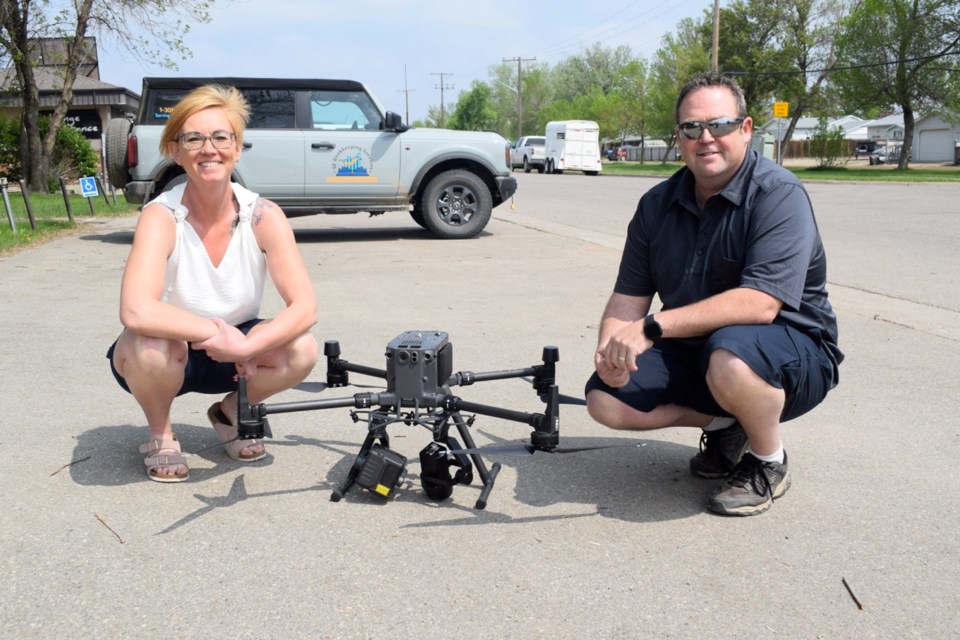ESTEVAN — Rod Cullen has been employed with coal mining operations in the Estevan area since 2010. And he enjoys his work.
But Cullen has also found an interest in drones, and that has led him to start up Predator Inspections Ltd.
Cullen, who is a heavy-equipment operator for Westmoreland Mining Holdings LLC, started with the mines by working in the service bay for about a month, and then moved into heavy equipment.
"I got onto the draglines as an oiler, progressed up to an operator, had a couple of operating bids on a couple of different machines," said Cullen.
He likes to be around the draglines. It is fun to operate them, he said, and he is intrigued to see how the gearing and components work. The people at the mines are great, too.
"I get to work with industrial mechanics, journeymen heavy-duty mechanics, welders and electricians. I get to see their trade and see how it fits with the dragline side of things," said Cullen.
He became a miner after working in the oilpatch. He decided to shift careers due to the uncertainty of the oil industry. He had to plan for spring break-up each year and weather was also an issue in his former profession.
Cullen moved to Estevan in 2009 and didn't know much about the mines, but was still encouraged to apply.
"The pay is good and the steady work schedule is good," he said. "It keeps you busy. I get to run the dozer. All that equipment is just fun to work with."
While the equipment is large, it's enjoyable to see the finesse work that can be done with heavy equipment.
Cullen took a hiatus from the mines for a couple of years, but was granted his certifications when he returned to mining
He already had his commercial pilot's licence when he became a miner. And he started working with drones because the other traditional aircraft jobs didn't appeal to him. Transport Canada also changed regulations for drone operations in 2019.
"With my … commercial aviation background, I studied up on the advanced [drone test], wrote the flight test and then it just seemed like it was a good segue with all of the sensors and capabilities of this drone in particular to adapt to farming, to oil and gas, to SaskPower inspections," he said.
The primary drone he has covers so much area in less time, he said, and is more efficient.
Predator Inspections has two drones. One, the bigger unit, which Cullen called an enterprise drone, has multiple censors that can be used, and is one of the few of its kind in Saskatchewan or Western Canada.
They just added a second one with a photogrammetry censor to do two-dimensional maps and three-dimensional models.
"That helps companies interact with their physical assets in the office on the computer," Cullen said. "You can get measurements, you can get volume calculations. You don't need to be out there measuring, climbing around the pumpjacks or the tanks to be measuring the lease.
"You can map it and model it, and it will give you elevation contour lines, some DSM – digital service models – so if you need to predict where a leak was most likely to happen, it will give you the elevation of the lease, so you know if you need more containment on a certain area, or want to add more soil or beef up your berms."
He has performed some demonstrations with SaskPower to show the zoom capabilities of his primary drone, particularly with one of its censors. It's 20 megapixels with a 23-times digital zoom.
"On a good day, you can see for … over a mile. If we're within 50 feet or 100 feet of something, it's really good resolution. You can see the cotter pins on bolts and stuff, and the one censor there's actually four censors in one, so it's got a thermal camera, it's got a laser range finder, it's got a wide 12-megapixel wide camera."
Cullen noted the laser methane censor is the only one in Saskatchewan, and was used to detect a gas leak that had been occurring in a natural gas line for three years. Operators had been sent out to check around and couldn't detect the problem.
He was able to pinpoint where the leak was coming from. A survey stake had punctured the line.
The primary drone could also have applications in agriculture that could help agronomists do their job. And once regulations change, it could create even more opportunities.
Cullen noted that when they had the idea for the business, they went to the Southeast Techhub to find out how to get it to the business stage. Techhub helped with searching for the name, making sure it wasn't taken. And Jeff Taylor, the former head of Southeast Business Startup, was really good at helping them find out which programs they could apply for.



